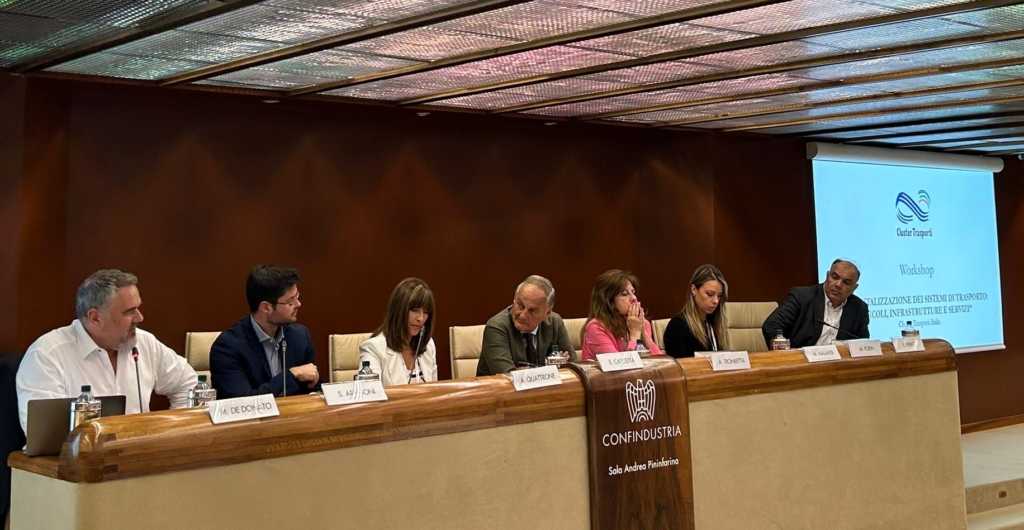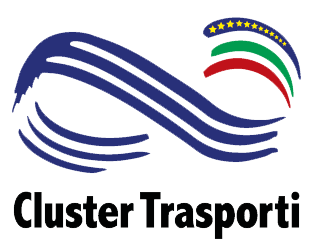The digitalization of transport systems: vehicles, infrastructures and services

Published 1 July 2024
“The digitalisation of transport systems: vehicles, infrastructures and services”, is the title of the workshop organized by Cluster Trasporti.
An event that put the importance of the transformations of recent years for the entire mobility system at the center of the debate.
The President of Cluster Trasporti Italia Ennio Cascetta introduced the works.
Among the speakers,Enrico Pisino, CEO Cim 4.0, Matteo Bandiera, coordinator of the HD-Motion project of CIM4.0, who addressed the topic: “The digitalisation of systems and the impact on industrial supply chains”, Gianpiero Mastinu, of the Polytechnic of Milan as well as Coordinator of the Transport Cluster Scientific Council, who reported in particular on “The digitalisation of motor vehicles”, Stefano Arrigoni, of the Polytechnic of Milan, whose report was focused on “The digitalisation of driving: autonomous driving and V2X ”, Marzia Malavisi, MOVYON Structural Monitoring Manager of the Autostrade per l’Italia Group, who spoke about “The digitalisation of infrastructures”, Marco Forin, Head of the Migration and Cyber Security Program of the National Logistics Platform of MIT Leonardo, whose report concerned “The digitalisation of goods”, Agata Quattrone, Innovation Manager Almaviva, who presented a speech on “The digitalisation of services” and Antonella Trombetta, Hitachi – Rail and General Secretary of the Transport Cluster, who addressed the topic of “The digitalisation of rail transport”.
In short, a broad and in-depth debate which, as the President of Cluster Trasporti Italia Ennio Cascetta underlined in the introduction to the proceedings, clearly outlined the current and future framework of the mobility system.
«The purpose of this workshop is that all actors in the mobility system can understand the processes underway – underlined President Cascetta – because interaction is fundamental. This is why today we will address from different points of view, from every possible angle, how much and how the digitalisation process is transforming the various components of the mobility system”.
The impact of digitalisation on the mobility system
«Our Cluster – began Enrico Pisino – approaches the world of technological evolution in systemic terms and in inter-sectoral terms, looking at full sustainability for 10 years now. The current Position Paper of the Automobile Manufacturers’ Association highlights how not only the sustainability of propulsion, the sustainability of transport but also the digitalisation of the transport system becomes strategic for competing as businesses. – continued Pisino – The challenges to reach the so-called Target Zero by 2050 are also fundamental for safety and not only for environmental impact. It is necessary to look at the mobility user and not just the driver when developing services. But above all, look at the evolution of this system because it has a heavy impact on both jobs and economic development. When we talk about the digitalisation of the transport system it does not only apply to road transport, it applies to transport and services. The car is no longer metallic hardware but software and hardware. Just as artificial intelligence is no longer just a prospect but a lever that must be brought within companies.”
The CIM4.0 HD-Motion project
«It is a European-wide project whose vertical is that of sustainable mobility – Matteo Bandiera began in his speech, illustrating the HD-Motion project of CIM4.0 – The three technologies on which the project leverages are artificial intelligence , high performance computing and cybersecurity, used to achieve competitiveness in both public administration and private companies. It boasts a large and heterogeneous partnership in order to have a holistic approach, on multiple fronts. There are four pillars: the test before invest, i.e. the validation of the concept, the product and testing, the training activities, access to financing and finally the ecosystem and the network, i.e. bringing together the subjects who experience mobility , creating synergies.”
The software defined vehicles of the future
Gianpiero Mastinu’s debut is surprising, but immediately understandable in addressing the depth of the issue.
«In a vehicle there are approximately 100 million lines of code compared to 25 million lines of code in a jet – Mastinu began – A figure that seems relevant but we expect already at the end of next year, 200 million lines of code and one billion by 2030. Currently the value of the hardware and software of a vehicle is around a third, but we will soon reach 50%. There is an ongoing public-private collaboration in which the European University has invested to relaunch the European electronics industry and to arrive at the software defined vehicles of the future, i.e. the definition of a vehicle based on the software. We need to rethink how the various vehicle systems talk to each other and therefore define standardized software modules. On board the vehicle there will be high performance computers which will integrate, with different types of architecture, the various embedded systems which will thus be able to interact with each other in a very short time and improve the exchange of information”.
Automation and digitalisation in driving
«Going into the detail of automation and therefore digitalisation of driving – Stefano Arrigoni intervened – A classification helps us. What is the current situation? We can divide the current situation into 4 areas. The first is consolidated technology where level 0 is an on-vehicle system capable of providing warnings and temporary driving supports as safety interventions. Level 1 is defined as driver assistance, where the driver is in full control of the vehicle but can decide to relinquish control of a vehicle for example steering in certain situations. These are consolidated systems that European legislation will make it mandatory for new vehicles to have on board from July. Level 2, partial automation, is a system that allows the control of the pedals and steering wheel to be handed over to the vehicle in certain driving conditions, but the authority for emergency monitoring remains in the hands of the driver. Level 3, however, defined as conditioned automation, allows the pilot to distract himself but if the system requests it he is required to intervene. There have been examples from Mercedes and Audi, but bureaucratic difficulties have so far put people off. – and continued by taking a look at the future Arrigoni – I define the subsequent levels 4 and 5 as frontier technology, that is, from a commercial technological point of view they do not yet exist. High automation level 4 means that in a certain driving condition the user can decide to completely hand over the driving operations to the vehicle itself. Theoretically the pilot could also sleep. But it was developed for a specific use case and although it is high the focus is rather vertical.
Level 5 is still under development: if a human driver is capable of driving in a certain condition, the car must also be able to drive with at least the same level of ability and safety.
From the reports it seems there is actually a strong push to work directly at higher levels of automation. The forecasts are actually for a jump directly to level 2.”
Digitalisation in the management of motorway infrastructure
«For a manager, probably the first step of digitalisation is to be able to use all the information – explained Marzia Malavisi in her speech, describing the Argo project by Movyon and ASPI – Bridges and viaducts date back on average 50 years ago, so the first step is a digitalisation of the land registry in order to have valid information and plan interventions. A lot of work is also being done on this with inspections. But technology and digitalisation can actually provide great support in monitoring the operational behavior of these assets over time. We are moving in the direction of preventive and predictive maintenance. What was done was to digitize all the works so that during the inspection activity all the information is available digitally and can be shared.”
Migration to the cloud
«The transition to the cloud, to cyber security, are key elements that must find application among operators – explained Marco Forin – Therefore it is essential to follow the technological operational activities and, in parallel, a training activity for end users. The project is ongoing and we hope to complete the migration activities by 2024 by bringing those who have joined the project to the cloud of the national logistics platform. During 2025 and 2026, complete the cyber security intervention”.
Smart mobility between present and future
«Over the last decade, the demand for mobility has undergone a mutation that we probably did not foresee – stated Agata Quattrone – The demand for mobility services has changed profoundly, the new generations are not interested in owning a private vehicle, they have interest in carrying out their journeys in sustainable ways, they need to be supported during their journeys by personalized and dynamic information. Now many in the private sector, but also in the public sector, are investing in the digitalisation of the mobility sector. In 2023 this market which brings together smart mobility, connected mobility, and driving assistance systems has almost reached 3 billion in turnover and between 2022 and 2023 the municipalities and territories have also identified smart mobility, the digitalisation of mobility services, a key strategic sector. – continued Quattrone, mentioning the ongoing projects – The projects that are most developed and under construction concern the strengthening of local public transport. The risk is always that these services are fragmented, the age-old problem of the intelligent transportation system has been their inability to interoperate, to be connected. Almaviva is investing in the creation of a transversal, digital and modular ecosystem that can be easily integrated and offer solutions to all mobility stakeholders, supporting the management of infrastructures, assets, planning and operational management of services for both passenger transport and goods. The control room offers system monitoring of both private transport and distraction events that may occur on the network, as well as dynamic monitoring of local public transport. In addition to satisfying the needs and expectations of the modern consumer, it is necessary to ensure that those who govern mobility can achieve their objectives of sustainability, efficiency and safety which are also the purpose of planning tools.”
The digitalisation of rail transport
«Smart delivery in our case is highly focused on manufacturing, engineering and development. And it is an internal revolution within the company. Then we have Smart Trains, which is perhaps the best known, the fact of having connected and autonomous vehicles. Currently, in the railway sector, we have the digitalisation of the vehicle through the TCMS, whereby all the vehicle equipment, such as door management or safety signaling, are now automatically connected in a standard way. And then instead we have autonomous driving, the T.O. and the insertion of sensors in order to increasingly help this autonomous driving. In a similar way to what was said for the automotive sector, our concept on the degree of automation is also how much and when man must intervene in particular cases of degradation or emergency. The other issue is Smart Maintenance, i.e. the need to monitor and maintain structures. Also in this case, the railway world has moved towards the digitalisation of asset management, in order to acquire as much data as possible to be able to carry out obviously predictive diagnostics. Data management and cyber security are extremely important, both in this and in Smart Mobility. And for Smart mobility – Trombetta continued as he drew to a close – it is essential to interconnect the railway and metropolitan parts. It is necessary to have tools that interconnect any type of mobility, be it goods or passengers, in order to create a truly efficient system. As for passengers, obviously also having a platform on their mobile phone that can give them any possible solution.”


